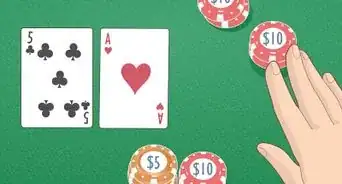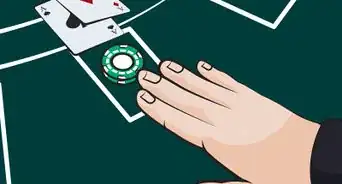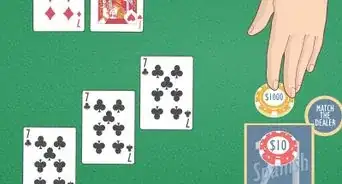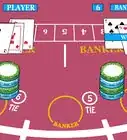This article was co-authored by wikiHow staff writer, Hunter Rising. Hunter Rising is a wikiHow Staff Writer based in Los Angeles. He has more than three years of experience writing for and working with wikiHow. Hunter holds a BFA in Entertainment Design from the University of Wisconsin - Stout and a Minor in English Writing.
There are 12 references cited in this article, which can be found at the bottom of the page.
This article has been viewed 122,631 times.
Learn more...
Blackjack is a gambling game where you try to get a hand totaling closer to 21 than the dealer. If you go over 21, then you automatically lose, or bust. Playing as the dealer in blackjack is similar to how you would play regularly, but with a few added responsibilities, like handing out cards and chips. As long as you have a solid understanding of how to play, you can easily deal blackjack and have fun doing it!
Steps
Starting a Hand of Blackjack
-
1Shuffle and cut the cards. Take the deck of cards out from the box and thoroughly mix them together. Use multiple techniques, such as riffle or overhand shuffles, to ensure the cards are randomized. Then, ask another player to place a red cut card anywhere in the middle of the deck. Once they place it, split the deck so the red cut card is on the bottom of one of the stacks. Place the other stack on top to finish the shuffle.[1]
- The cut card is a solid red card placed in the deck that marks where the cards should be separated during the cut. It's not totally necessary, but it can be helpful when cutting the deck.
- If you’re playing with a large group, you can combine up to 6 or 8 decks to change the odds of the game.
Tip: If you have a card shoe to make it easier to deal, set the cards inside so they’re face-down and easy to pull from the slot.
-
2Have the players place their bets for their hands. If you’re on a blackjack table, then have the players set their bets in the small circle in front of them. Wait until each player has either placed their chips for the bet or until they decide to leave the table. Make sure not to deal any cards before they place their bets.[2]
- You do not place bets on your hand as a dealer.
Tip: If a player doesn’t place their bet before you start dealing, then they must sit out for the round.
Advertisement -
3Deal 1 card face-up to all the players from left to right. Pull a single card from the top of the deck and slide it across the table to the first person to your left. Flip the card face-up while you’re sliding it and set it in the box in front of the player. Keep giving 1 card to each player from left to right across the table.[3]
- Try to place the card in the box without having to readjust it. Practice sliding the cards across the table if you can.
- Don’t let the players touch the cards, especially if you’re dealing in a professional setting.
-
4Set 1 card face-down in front of you. Take the next card from the deck and slide it face-down in front of you. Make sure you keep the card pressed flat on the table so the players don’t see what card’s value is. Don’t look at the card after you deal it.[4]
-
5Deal 1 more face-up card to the players and yourself. Start with the player on your left and deal them another card from the deck. Flip the card face-up and set it on top of the first card so you can still read the numbers in the corner. Keep dealing cards to the players around the table, and then set 1 card face-up in front of you. You can then start your round of blackjack.[5]
- If you deal yourself an ace, then you need to ask the players for “insurance.”
Dealing the Players’ Cards
-
1Deal 1 card if the player wants to hit. Ask the player directly to your left what they want to do with their hand. If they want to get closer to 21, they’ll ask to hit. Take the top card from the deck and slide it over to their hand, and flip it over to set it on top. Total the card values and tell the player the new total. If the player wants to hit again, give them another card.[6]
Tip: Learn the values of the cards so you can add them together easily. Face cards are worth 10, cards numbered 2-10 are worth their printed values, and aces can either count as 1 or 11.
-
2Take the player’s cards and bets if they total more than 21. If the player hits and the cards total 22 or higher, then the player busts and loses the round. Collect that player’s cards and set them aside as a discard pile. Then, take the busted player’s chips they placed as a bet and put them along with the rest of the chips in the chip holder.[7]
- Players who bust automatically lose the round and lose their entire bet.
- You win the bet as the dealer, but the chips go to the bank rather than paid out to you.
-
3Move on to the next player when the player you’re dealing to wants to stand. If the player is close to 21 and doesn’t want to press their luck, they’ll ask to stand. When a player stands, stop dealing them cards and move on to the next player. Keep working across the table from left to right, dealing cards to each player one at a time.[8]
- Players can hit as few or as many times as they want before they stand.
Finishing a Round
-
1Flip over your face-down card and total your cards. Once all the players have taken their turn, then take your turn as the dealer. Reveal the card you dealt yourself at the beginning of the round and total the value of your cards.[9]
- If you had a 10 or face card and reveal an ace, then you got a blackjack and automatically win against players with a smaller hand.
-
2Take another card if the count is under 17. If the total of your cards is 16 or lower, then draw a card from the top of the deck and set it face-up next to the other cards in your hand. If the total is still under 17, then draw cards until your hand is over 17. If you draw a card that puts your total over 21, then you bust, and the other players who are still in win the hand.[10]
- If the total is over 17, then you cannot keep hitting to get closer to 21.
-
3Compare your hand to those of the players. Look at the total values of the players’ hands to see if they are greater or lesser than your hand. If players have a hand closer to 21 than you without going over, then they win. If they have a worse hand than you, then they lose and you collect their bets.[11]
- If a player has the same total as you, then the hand is considered a “push.”
-
4Pay out the players’ bets. If players were closer to 21 than you, then they receive a 1:1 payout that’s twice the amount they bet. If the player won with a blackjack, showing a 10 and an ace, then they are usually paid 3:2 on their bet, meaning they get 2.5 times the amount they bet. If you have a “push” where you have the same total as another player, neither you nor the player wins. The player then gets their bet back.[12]
- For example, if a player bets 10 chips and won, they would win 20 chips from the bank. If they won with a blackjack, then they would win 25 chips.
Tip: Betting odds may vary depending on the table you’re working at. Check with the table rules before your games so you know the exact payout.
-
5Discard and shuffle all of the cards that were played. Collect all the cards from each of the players and set them face-down in your discard pile. If you’re only playing with a single deck of cards, shuffle the discard pile with the rest of the deck after each hand.[13]
- If you’re using multiple decks, then you don’t need to shuffle until you’re about halfway through the cards.
Addressing Special Hands
-
1Ask the players if they want “insurance” if your face-up card is an ace. If you deal your hand and the face-up card is an ace, you need to ask the players for insurance. Let the players pay up to half of their initial bet as their insurance. Look at your face-down card and reveal it if it’s a 10. If it is, take the initial bets from any players who lost against your hand. Then pay any players with insurance double the amount they paid.[14]
- For example, if a player paid 3 chips for insurance, then they would get 6 chips from the bank if you have a blackjack.
- If a player pays insurance, they won't lose as many chips if you have a blackjack right when you begin dealing.
- If you don’t have a blackjack, then take the chips the players paid for insurance and put them in the bank.
Tip: Players don’t need to pay insurance if they don’t think they you have a blackjack or if they also have a blackjack.
-
2See if players want to “double down” to bet more chips. A player can choose to double their bet if they’re confident with their hand. If they want to double down, wait for them to place their additional bet on the table before dealing them 1 more card. Lay the card horizontally across the top of their hand to show they cannot hit on that hand anymore.[15]
- If the player that doubled down wins against your hand, then they win double the amount of money. For example, if the player bet 5 chips initially and then won after doubling down, they would win 20 chips from the bank.
-
3Give players the option to “split” if they were dealt cards with the same value. When players are dealt the same card, they can choose to separate them into 2 hands. Move the top card on their hand over and ask them to place another bet equal to the first one on the table. Deal 1 more face-up card for each hand and play them from left to right.[16]
- If a player gets a blackjack on a split hand, they win 1:1 payout rather than 3:2.
Our Most Loved Articles & Quizzes
Community Q&A
-
QuestionWhat happens when the dealer and player tie in Blackjack?
 wikiHow Staff EditorThis answer was written by one of our trained team of researchers who validated it for accuracy and comprehensiveness.
wikiHow Staff EditorThis answer was written by one of our trained team of researchers who validated it for accuracy and comprehensiveness.
Staff Answer wikiHow Staff EditorStaff AnswerIf the player and dealer have a tie, the round is considered a “push.” Nobody loses or wins any money on this bet.
wikiHow Staff EditorStaff AnswerIf the player and dealer have a tie, the round is considered a “push.” Nobody loses or wins any money on this bet. -
QuestionDoes a blackjack hand automatically win?
 wikiHow Staff EditorThis answer was written by one of our trained team of researchers who validated it for accuracy and comprehensiveness.
wikiHow Staff EditorThis answer was written by one of our trained team of researchers who validated it for accuracy and comprehensiveness.
Staff Answer wikiHow Staff EditorStaff AnswerYes—any 2-card hand that adds up to 21, which is called a “blackjack” or “natural”—will automatically win the bet. However, if both the player and the dealer have a blackjack, then the bet is tied and nobody wins anything.
wikiHow Staff EditorStaff AnswerYes—any 2-card hand that adds up to 21, which is called a “blackjack” or “natural”—will automatically win the bet. However, if both the player and the dealer have a blackjack, then the bet is tied and nobody wins anything. -
QuestionWhat is the 5-card rule in Blackjack?
 wikiHow Staff EditorThis answer was written by one of our trained team of researchers who validated it for accuracy and comprehensiveness.
wikiHow Staff EditorThis answer was written by one of our trained team of researchers who validated it for accuracy and comprehensiveness.
Staff Answer wikiHow Staff EditorStaff AnswerSome versions of Blackjack have a rule called “5 Card Charlie,” in which a hand of 5 cards receives an automatic win. However, most casinos don’t use this rule.
wikiHow Staff EditorStaff AnswerSome versions of Blackjack have a rule called “5 Card Charlie,” in which a hand of 5 cards receives an automatic win. However, most casinos don’t use this rule.
Warnings
- Only bet money if you’re comfortable gambling it. Otherwise, use chips or other score trackers to keep track of your winnings.⧼thumbs_response⧽
Things You’ll Need
- Playing cards
- Poker chips
References
- ↑ https://youtu.be/LE-PaCEidAQ?t=37
- ↑ https://blog.udemy.com/blackjack-rules-2/
- ↑ https://youtu.be/mx5FYBgT2GM?t=19
- ↑ https://youtu.be/mx5FYBgT2GM?t=38
- ↑ https://youtu.be/mx5FYBgT2GM?t=40
- ↑ https://youtu.be/mx5FYBgT2GM?t=53
- ↑ https://youtu.be/mx5FYBgT2GM?t=87
- ↑ https://youtu.be/mx5FYBgT2GM?t=118
- ↑ https://blog.udemy.com/blackjack-rules-2/






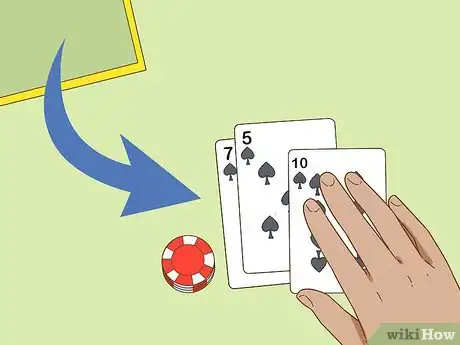







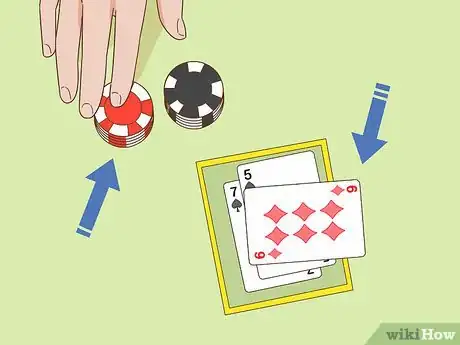









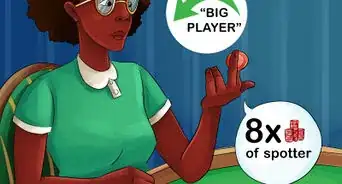

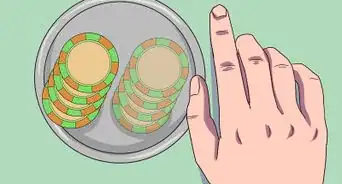
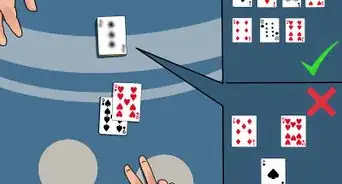
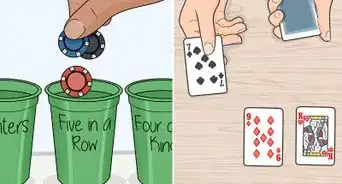
-Step-25.webp)
